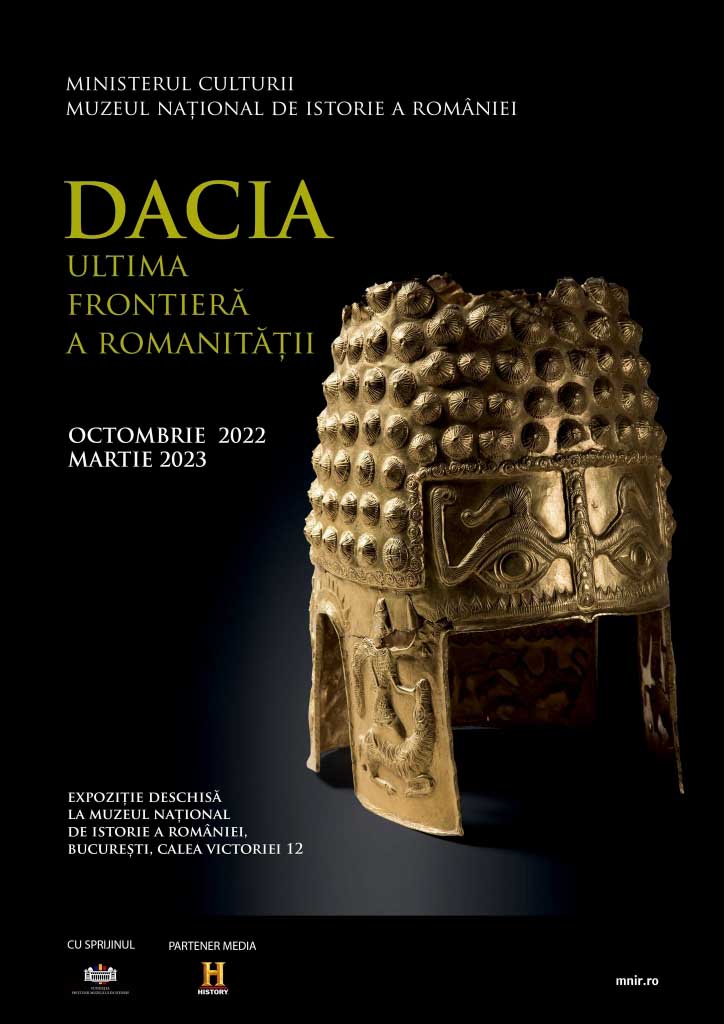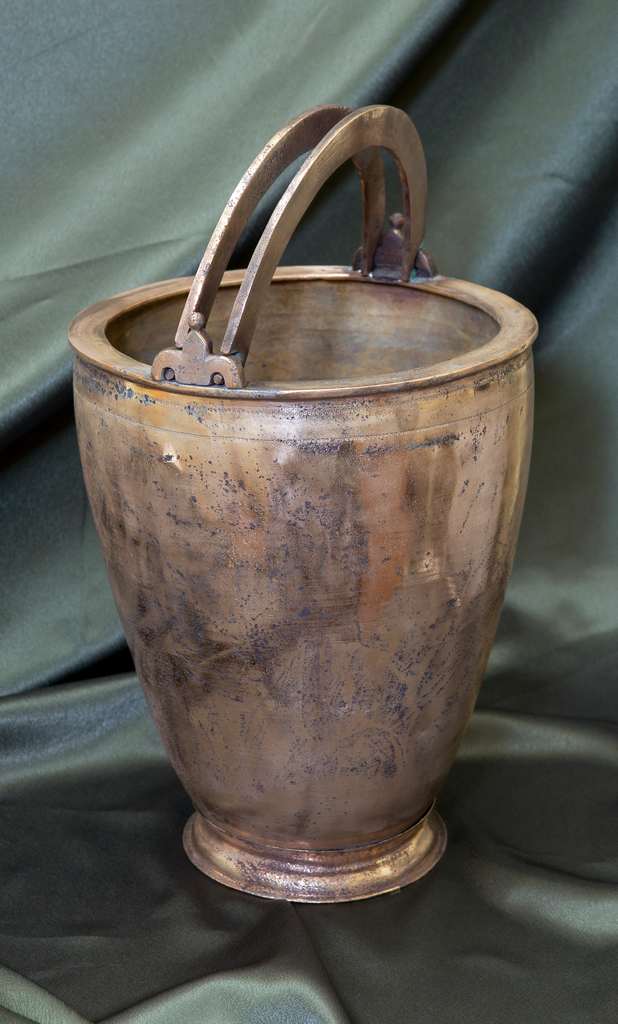 The exhibition "Dacia. The last frontier of Romanianness" is based on the exhibition concept materialized in a very successful project, "Archaeological treasures from Romania. Dacian and Roman roots", realized in 2021, at the prestigious National Museum of Archeology in Madrid. This is the largest synthetic exhibition dedicated to the civilization of the Getae and Dacians, the Romanian one, as well as those of the first migrants in this space, organized in the last 25 years, through an effort of 45 museum institutions from Romania and the Republic of Moldova, project coordinated by the National History Museum of Romania.
The exhibition "Dacia. The last frontier of Romanianness" is based on the exhibition concept materialized in a very successful project, "Archaeological treasures from Romania. Dacian and Roman roots", realized in 2021, at the prestigious National Museum of Archeology in Madrid. This is the largest synthetic exhibition dedicated to the civilization of the Getae and Dacians, the Romanian one, as well as those of the first migrants in this space, organized in the last 25 years, through an effort of 45 museum institutions from Romania and the Republic of Moldova, project coordinated by the National History Museum of Romania.
The exhibition project was designed and coordinated by the National History Museum of Romania, under the auspices of the Ministry of Culture, carried out in collaboration with the National Museum of History of Moldova - Chisinau, the National Museum of Transylvania History - Cluj Napoca, the National Museum Complex of Moldova - Iași, Neamț National Museum Complex - Piatra Neamț, "Iulian Antonescu" Museum Complex - Bacău, Bistrița Nasăud Museum Complex - Bistrița, "Curtea Domnească" National Museum Complex - Târgoviște, "Vasile Pârvan" Archeology Institute - Bucharest, Eco-Museum Research Institute "Simion Gavrilă" - Tulcea, Braila Museum "King Carol I" - Brăila, Dacian and Roman Civilization Museum - Deva, Gumelnița Civilization Museum - Oltenița, Prahova County Museum of History and Archeology - Ploiesti, Maramureș County Museum of History and Archeology - Baia Mare, National Union Museum - Alba Iulia, "Paul Păltânea" County Museum of History - Galati, Argeș County Museum - Pitesti, Mu Botoșani County Museum, Brașov County Museum of History, Buzău County Museum, Gorj "Alexandru Ștefulescu" County Museum - Târgu Jiu, Ialomița County Museum - Slobozia, Mureș County Museum - Târgu Mureș, Olt County Museum - Slatina, Satu Mare County Museum, Museum Teleorman County - Alexandria, Vâlcea County Museum "Aurelian Sacerdoțeanu" - Râmnicu Vâlcea, "Ștefan cel Mare" County Museum - Vaslui, Zalău County Museum of History and Art, Bucharest City Museum, Carei Municipal Museum, Banat National Museum - Timișoara, Museum National Museum of Bucovina - Suceava, Museum of National History and Archeology - Constanta, Museum of Oltenia - Craiova, Museum of the Iron Gates Region - Drobeta-Turnu Severin, Museum of Romanization - Caracal, Museum of the Country of Crișurilor - Oradea, Museum of the Country of Făgăraș "Valer Literat" - Făgăraș, "Vasile Pârvan" Museum - Bârlad, "Teodor Cincu" History Museum - Tecuci, Turda History Museum, Romanian History Museum, and History Museum "Petre Voivozeanu" - Roșiori de Vede. Done with the support of the "Friends of the Romanian History Museum" Foundation.
The exhibition is structured chronologically on six generic themes:
- The final stage of the first Iron Age and the connections of the locals with the Scythian worldꓽ ceramic pieces, weapons and ornaments, specific to the late Hallstatt cultures, are presented;
- Terra Dacorumꓽ is dedicated to the ancient civilizations that developed on the territory of Romania during the second iron age - La Tène. The central role belongs to the civilization developed by the Geto-Dacians, in the space defined by the western shore of the Black Sea, the Carpathian basin and the Danube River;
- At the gates of the Empireꓽ is dedicated to the communities in the space previously inhabited by the Geto-Dacians, the transformations they undergo in the context of the new realities generated by the presence of the empire and the coexistence of the free Dacians with the Germanic and Sarmatian tribes settled here in the first three centuries of the Christian era;
- Building Terra Christianaꓽ the period of the 4th - 7th centuries AD is characterized by three decisive historical milestones for this space: the withdrawal of the army and the administration from the Province of Dacia, the penetration of Christianity and the great migrations;
- The "Barbarians" and the Empire - The transformation of the Roman world - daily life and conflictꓽ browsing the writings of Late Antiquity about Dacia, the perception of the Danube as a political and symbolic border, one of the main landmarks of the political initiatives of the Empire or of some populations in migration, is outlined. At the same time, during the IV-VII centuries, the area north of the Lower Danube was also an area of continuity of the provincial Roman civilization and of cultural synthesis of its heritage with the cultures of various Germanic, Iranian, Slavic or Central Asian migrant populations.
The following pieces will be presented from the collection of the National History Museum of Romania: the golden helmet from Coțofenești, the Getic treasures from Stâncești, Agighiol, Peretu, the Getic princely treasure from Cucuteni-Băiceni, the inventory of the tomb of a Getic chieftain from Popești, the treasures of Dacian silver from Sâncrăieni, Herăstrău, Senereș, Vedea, two unknown hoards from S-W Romania, inscriptions mentioning the Dacian kings Tiamarkos, Burebista and Decebal, imperial portraits of Trajan, Antoninus Pius, Marcus Aurelius, Traianus Decius, Sarmatian hoards from Buzau county and Smârdan, the hoards from Pietroasele, Apahida and Histria (from the migration era).
From the collections of the partner museums we list: treasures dating from the era of migrations discovered in the tombs of some princesses, in Cluj-Polus and Turda (from the heritage of the National Museum of Transylvania and the Turda History Museum), the cache of weapons and Greek bronze objects from Olănești, as well and gold pieces from the tombs of a Sarmatian princess from Mocra, Republic of Moldova, from the heritage of the National Museum of History of Moldova in Chisinau, ceramic vessels, weapons, tools and ornaments from common metals that illustrate the evolution of civilizations that succeeded each other in space from the north of the Danube in the period between VII B.C.E. and the end of the century VII AD.
We invite you on a journey of over 1400 years, in time, in space, in the universe where the ancestors of the Geto-Dacians evolved towards what the ancient sources will call the Getae and Dacians, the civilization developed by them until the conquest and transformation of a part of Dacia in the Roman province, the integration of this space into the Roman world, the survival of the provincial Roman civilization after the abandonment of Dacia by the Roman army and administration and the cohabitation of the locals with the migratory populations. The guiding thread of the exhibition is that of the interweaving and mutual influence of civilizations, of profound transformations, of creative and adaptive turmoils that have as their finality the creation of a cultural identity, along a time path that lasts from the end of the first Iron Age to the dawn of the present of European civilization, in a space perceived by the contemporaries of the troubled dark millennium of migrations, as the "Last Frontier of Romanity", the place where the linguistic foundation laid by the Latin language and the name of the Romans have survived, despite all the vicissitudes, until today.
The exhibition will be open until March 2023 and can be visited from Wednesday to Sunday.

















































